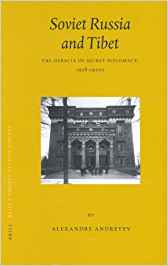In the long and chequered annals of Tibet, India to the South and China to the West have played—and indeed continue to play—very significant roles. Expectedly, both have contributed a great deal to the texture of Tibetan life. The Chinese, more demonstrative in food and dress and to a degree in the organization of government; the Indians, deeper and more inward-looking in matters of religion, moral ideas and literary models. Essentially non-military and non-political, India’s major emphasis was on cultural ties; China’s on political linkages.This is not to say that other countries in Asia have not impacted the land of the lama, much less left it untouched. Thus, both the Japanese, a faraway island nation to the East, or Russia, a huge landmass to the North and West have done so, to no small degree. The Russian contacts go far back into the eighteenth century; the Japanese, more recent, relate principally to the first half of the twentieth. Andreyev’s impressive tome under review deals mainly with the Soviet interlude over a couple of decades. The body of the work falls into half a dozen slots starting with ‘The Bolsheviks enter the scene’ (Chapter 2) to winding up with ‘The final efforts to win Tibet over’ (Chapter 7).

Cultural and Political Linkages
Parshotam Mehra
SOVIET RUSSIA & TIBET: THE DEBACLE OF SECRET DIPLOMACY, 1918-1930S by Alexandre Andreyev Brill, Leiden, 2004, 433 pp., price not stated
March 2004, volume 28, No 3
